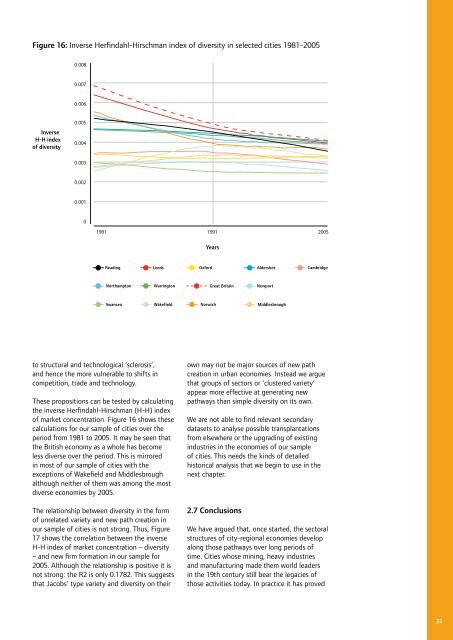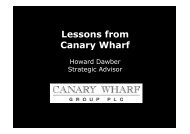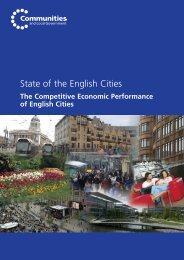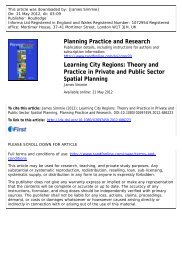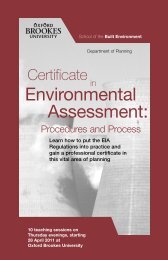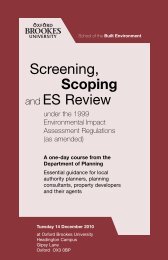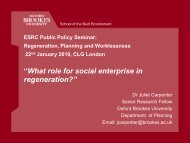History Matters: Path dependence and innovation in British city ...
History Matters: Path dependence and innovation in British city ...
History Matters: Path dependence and innovation in British city ...
You also want an ePaper? Increase the reach of your titles
YUMPU automatically turns print PDFs into web optimized ePapers that Google loves.
Figure 16: Inverse Herf<strong>in</strong>dahl-Hirschman <strong>in</strong>dex of diversity <strong>in</strong> selected cities 1981-2005<br />
0.008<br />
0.007<br />
0.006<br />
Inverse<br />
H-H <strong>in</strong>dex<br />
of diversity<br />
0.005<br />
0.004<br />
0.003<br />
0.002<br />
0.001<br />
0<br />
1981 1991<br />
2005<br />
Years<br />
Read<strong>in</strong>g Leeds Oxford Aldershot Cambridge<br />
Northampton Warr<strong>in</strong>gton Great Brita<strong>in</strong><br />
Newport<br />
Swansea Wakefield Norwich Middlesbrough<br />
to structural <strong>and</strong> technological ‘sclerosis’,<br />
<strong>and</strong> hence the more vulnerable to shifts <strong>in</strong><br />
competition, trade <strong>and</strong> technology.<br />
These propositions can be tested by calculat<strong>in</strong>g<br />
the <strong>in</strong>verse Herf<strong>in</strong>dahl-Hirschman (H-H) <strong>in</strong>dex<br />
of market concentration. Figure 16 shows these<br />
calculations for our sample of cities over the<br />
period from 1981 to 2005. It may be seen that<br />
the <strong>British</strong> economy as a whole has become<br />
less diverse over the period. This is mirrored<br />
<strong>in</strong> most of our sample of cities with the<br />
exceptions of Wakefield <strong>and</strong> Middlesbrough<br />
although neither of them was among the most<br />
diverse economies by 2005.<br />
The relationship between diversity <strong>in</strong> the form<br />
of unrelated variety <strong>and</strong> new path creation <strong>in</strong><br />
our sample of cities is not strong. Thus, Figure<br />
17 shows the correlation between the <strong>in</strong>verse<br />
H-H <strong>in</strong>dex of market concentration – diversity<br />
– <strong>and</strong> new firm formation <strong>in</strong> our sample for<br />
2005. Although the relationship is positive it is<br />
not strong: the R2 is only 0.1782. This suggests<br />
that Jacobs’ type variety <strong>and</strong> diversity on their<br />
own may not be major sources of new path<br />
creation <strong>in</strong> urban economies. Instead we argue<br />
that groups of sectors or ‘clustered variety’<br />
appear more effective at generat<strong>in</strong>g new<br />
pathways than simple diversity on its own.<br />
We are not able to f<strong>in</strong>d relevant secondary<br />
datasets to analyse possible transplantations<br />
from elsewhere or the upgrad<strong>in</strong>g of exist<strong>in</strong>g<br />
<strong>in</strong>dustries <strong>in</strong> the economies of our sample<br />
of cities. This needs the k<strong>in</strong>ds of detailed<br />
historical analysis that we beg<strong>in</strong> to use <strong>in</strong> the<br />
next chapter.<br />
2.7 Conclusions<br />
We have argued that, once started, the sectoral<br />
structures of <strong>city</strong>-regional economies develop<br />
along those pathways over long periods of<br />
time. Cities whose m<strong>in</strong><strong>in</strong>g, heavy <strong>in</strong>dustries<br />
<strong>and</strong> manufactur<strong>in</strong>g made them world leaders<br />
<strong>in</strong> the 19th century still bear the legacies of<br />
those activities today. In practice it has proved<br />
33


